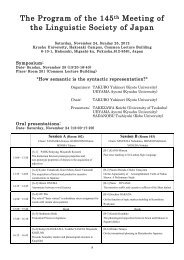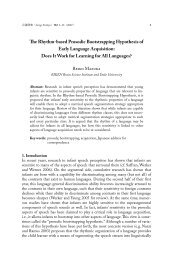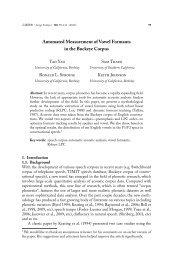第117åæ¥æ¬è§£åå¦ä¼ç·ä¼ã»å ¨å½å¦è¡éä¼ è¬æ¼ããã°ã©ã ã»æé²é PDF ...
第117åæ¥æ¬è§£åå¦ä¼ç·ä¼ã»å ¨å½å¦è¡éä¼ è¬æ¼ããã°ã©ã ã»æé²é PDF ...
第117åæ¥æ¬è§£åå¦ä¼ç·ä¼ã»å ¨å½å¦è¡éä¼ è¬æ¼ããã°ã©ã ã»æé²é PDF ...
You also want an ePaper? Increase the reach of your titles
YUMPU automatically turns print PDFs into web optimized ePapers that Google loves.
96<br />
117 <br />
S<br />
<br />
1,2 1,2 1 1,3 <br />
4 - 1 1,5 1 <br />
1 1,6 1<br />
1<br />
2 <br />
3<br />
JST, CREST 4 5 <br />
6 MRC <br />
<br />
Corticothalamic projection neurons (CTNs) in the cerebral cortex<br />
constitute an important component of the thalamocortical reciprocal<br />
circuit, an essential input/output organization for cortical information<br />
processing. However, the spatial organization of local excitatory<br />
connections to CTNs is only partially understood. Here, applying a<br />
newly developed adenoviral vector, we retrogradely visualized almost<br />
all layer (L) 6 CTNs from their cell bodies to fine dendritic spines in<br />
the rat barrel cortex. In cortical slices containing visualized L6 CTNs,<br />
we intracellularly stained single L2/3, L4, L5, and L6 pyramidal/<br />
spiny neurons and morphologically examined their local connections<br />
to CTNs. The CTNs received strong and focused connections from<br />
the L4 neurons just above them, and the most numerous nearby and<br />
distant sources of local excitatory connections to CTNs were CTNs<br />
themselves and L6 putative corticocortical neurons, respectively. The<br />
present results suggest that, through CTNs, L4 neurons together with<br />
L6 neurons may serve to modulate thalamic activity.<br />
S<br />
<br />
Recurrent connection selectivity of layer V pyramidal<br />
cells in frontal cortex<br />
1,2 1,2<br />
1<br />
2 <br />
Pyramidal cells in the neocortex are differentiated into several<br />
subgroups based on their extracortical projection targets. However,<br />
little is known regarding the relative intracortical connectivity<br />
of pyramidal cells specialized for their targets. We used paired<br />
recordings and quantitative morphological analysis to reveal<br />
distinct synaptic transmission properties, connection patterns, and<br />
morphological differentiation of rat frontal cortex. Retrograde<br />
tracers were used to label two projection subtypes in L5: crossedcorticostriatal<br />
(CCS) cells projecting to both sides of the striatum,<br />
and corticopontine (CPn) cells projecting to the ipsilateral pons.<br />
Although CPn/CPn and CCS/CCS pairs had similar connection<br />
probabilities, CPn/CPn pairs exhibited greater reciprocal connectivity,<br />
stronger unitary synaptic transmission, and more facilitation of<br />
paired-pulse responses. These synaptic characteristics were strongly<br />
correlated to the projection subtypes. CPn and CCS cells were further<br />
differentiated in their dendritic/ axonal arborization. Together, our<br />
data demonstrate that the pyramidal projection system is segregated<br />
according to subcortical target.<br />
S<br />
A Hz Oscillation Synchronizes Prefrontal, VTA, and<br />
Hippocampal Activities during Working memory<br />
Gyorgy Buzsaki<br />
Rutgers University<br />
Network oscillations support transient communication across brain<br />
structures. We show here, in rats, that task-related neuronal activity<br />
in the medial prefrontal cortex (PFC), hippocampus and ventral<br />
tegmental area (VTA), regions critical for working memory, is<br />
coordinated by a 4-Hz oscillation. A prominent increase of power<br />
and coherence of the 4-Hz oscillation in the PFC and VTA and its<br />
phase-modulation of gamma power in both structures was present<br />
during working memory. Subsets of both the PFC and hippocampal<br />
neurons predicted the turn choices of the rat. The goal-predicting<br />
PFC pyramidal neurons were more strongly phase-locked to both<br />
4-Hz and hippocampal theta oscillations than non-predicting cells.<br />
The 4-Hz and theta oscillations were phase-coupled and jointly<br />
modulated both gamma waves and neuronal spikes in the PFC, VTA<br />
and hippocampus. Thus, multiplexed timing mechanisms in the PFC-<br />
VTA-hippocampus axis may support processing of information,<br />
including working memory.<br />
S<br />
Development of orientation and direction selectivity<br />
in the mouse visual cortex<br />
1,2 Nathalie Rochefort 2 Christine Grienberger 2 <br />
Nima Marandi 2 Daniel Hill 2 Arthur Konnerth 2<br />
1<br />
2 Inst. Neuroscience, Technical<br />
Univ. Munich<br />
Functional features of the cortical neurons such as direction<br />
selectivity (DS) in the visual cortex are established during<br />
development. Previous studies of the ferret visual cortex implied<br />
that experience-dependent plasticity of local circuits in the cortex<br />
contributed to the development of DS. In spite of their usefulness, it<br />
has been less understood that how the rodent visual system develops.<br />
Here we used two-photon Ca 2+ imaging to study the development of<br />
DS in layer 2/3 neurons of the mouse visual cortex in vivo. At eyeopening,<br />
nearly all orientation-selective neurons were also directionselective.<br />
DS developed normally in dark-reared mice, indicating that<br />
the early development of DS is independent of vision. Furthermore,<br />
remarkable functional similarities existed between the development<br />
of DS in cortical neurons and the previously reported development<br />
of DS in the mouse retina. Together, these findings suggest a new<br />
experience-independent circuit mechanism for the development of DS<br />
in the mammalian brain. Since rodents lack columnar organization<br />
in the visual cortex, difference in the local connectivity may explain<br />
different developmental profile between species.







